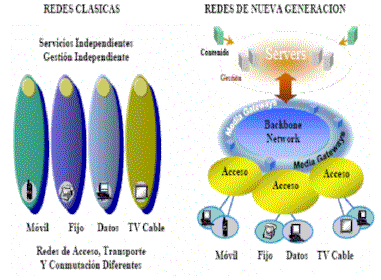|
1. A NEW TECHNOLOGICAL REALITY
In the mid-1990s, we were
introduced to a new technological reality resulting
from the emergence of the Internet protocol (IP),
based on the possibility of integrating
telecommunication networks via the Internet, moving
from different protocols for voice and data service
provision (e.g., X.25, ATM, or Frame Relay) to the
possibility of integrating different services via a
single protocol (IP). It ultimately meant the very
possibility of using a single network to provide
different services.
• Convergence scheme

Reference:
PROTOCOL CONVERGENCE
Platforms based on multiple separate protocols
Networks based on a single protocol
CONVERGENCE OF SERVICES AND
NETWORKS
TRADITIONAL NETWORKS
Telephony
Television
Broadcasting Network of networks
Messaging
Data transmission
CONVERGENT SERVICES & NETWORKS
As can be seen from the figure,
we have moved from a system of multiple
technological platforms, each with its own protocol,
to a system where all platforms can be IP-based.
We have also moved from a concept
of multiple networks, depending on the type of
service to be provided, to IP-based networks
designed to provide convergent services.
Therefore, technological
convergence (as a force driving a new
telecommunication regulatory model) is the
implementation of single, IP-based,
telecommunication networks for the provision of
different services formerly provided over separate
networks.
IP is a protocol used for
communication over a network via packet switching
(as opposed to traditional switched circuit
networks) where the bandwidth available for
communication is essential. IP is the communications
protocol most implemented today, and the one
enabling convergent telecommunication services to be
provided. However, this does not mean that earlier,
pre-IP, protocols should be discarded. On the
contrary, one advantage of IP-based New Generation
Networks (NGN) networks is precisely that they
afford the possibility of operating jointly with or
integrated into traditional networks.
Little by little, IP has become
not only the most widely used communications
protocol, but also a veritable force driving
technological development in connection with the
development of a new telecommunication network
concept. Its advantage is that it makes possible
presence on any type of network, fixed or mobile,
that is, it is a protocol designed to serve as an
open architecture model consistent with the OSI
(Open Systems Interconnection) model, so that it can
be used on any type of network, such as fiber optic
or GPON, or mobile networks such as WiMAX or LTE-based
next generation cellular networks.
Important developments have taken
place with IP in the last ten years, moving from an
initial version characterized by the “best effort”
concept in packet transmission, where service
quality was not guaranteed, to much more developed
versions, such as IPv4 or IPv6, where not only is
point-to-point service quality guaranteed, but the
possibility also exists of controlling or managing
the entire IP-based network.
This IP evolution has enabled a
new telecommunication concept to emerge, associated
with NGN networks. These are becoming the veritable
force driving technological convergence, with IP as
their fundamental support at the network’s heart.
Thus, IP has become not only the force driving the
technological convergence concept, but also the
force driving the establishment of a new concept of
networks (NGN) which, as we will see, will be those
gradually implemented as operators decide to update
their networks so as to be able to provide new
telecommunication services or applications.
IP, associated with NGN networks,
makes numerous applications available (voice, video,
data) on different terminals, fixed or mobile, since
they are capable of integrating different
technologies meeting information needs of users,
providing them with total information transmission
transparency, i.e., regardless of the transport
technology used by the service provider.
• Diagram: From a traditional
network to an NGN multiservice network

Reference:
Traditional Networks Next
Generation Networks
Independent services Content
Independent administration Administration
Mobile Fixed Data Cable TV Access Access Access
Different access, transport, and switching
networks Mobile Fixed Data Cable TV
According to the International
Telecommunication Union (ITU), in ITU-T
Recommendation Y.2001, Study Group 13,
Standardization Sector, a Next Generation Network (NGN)
is:
“… a packet-based network able to
provide Telecommunication Services to users and able
to make use of multiple broadband, QoS-enabled
transport technologies and in which service-related
functions are independent of the underlying
transport-related technologies. It enables
unfettered access for users to networks and to
competing service providers and services of their
choice.
It supports generalized mobility
which will allow consistent and ubiquitous provision
of services to users.”
As may be seen from the figure
above and the definition contained in the ITU
Recommendation, NGNs’ importance lies in the fact
that they: (i) enable multiple services to be
provided over a single network; and (ii) enable
traditional networks to be integrated with the NGN
network so that operators need not dispose of their
old networks, but instead can integrate them into
the new NGN network, making any gradual migrations
required so that the network eventually becomes 100%
IP in keeping with the operator’s needs.
Francisco Castro
Coordinator
Asociación Colombiana de Ingenieros |


